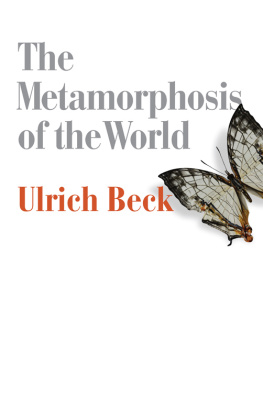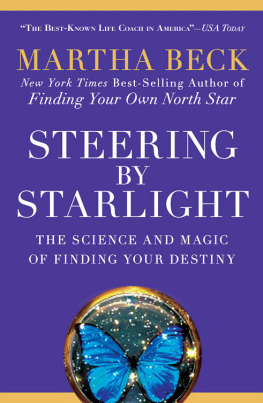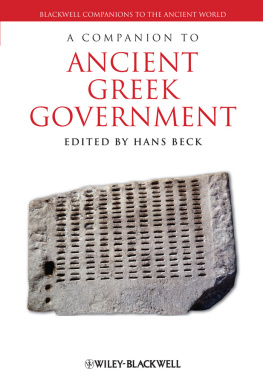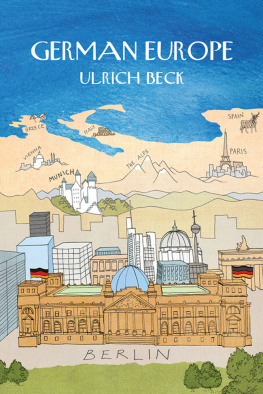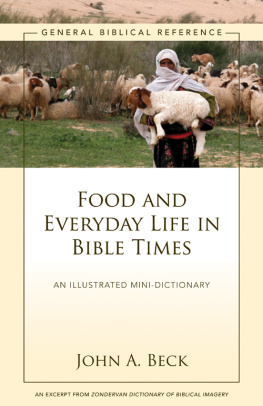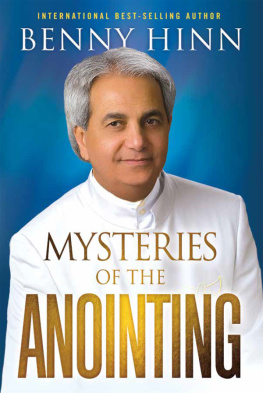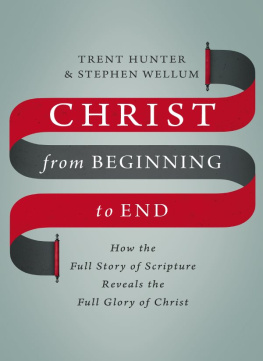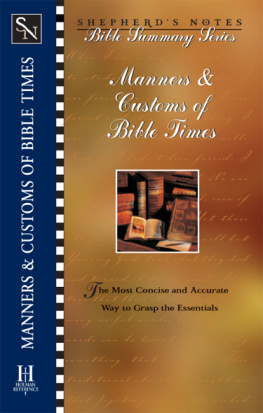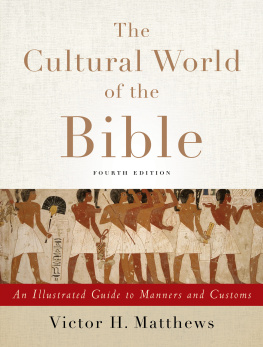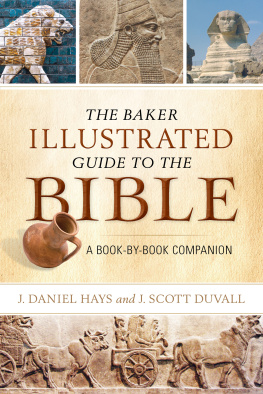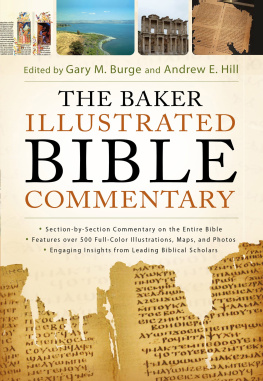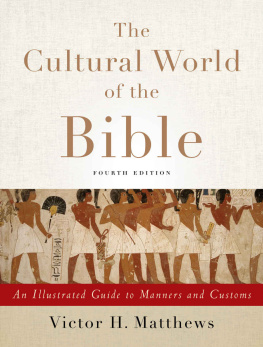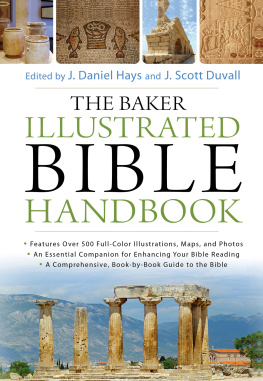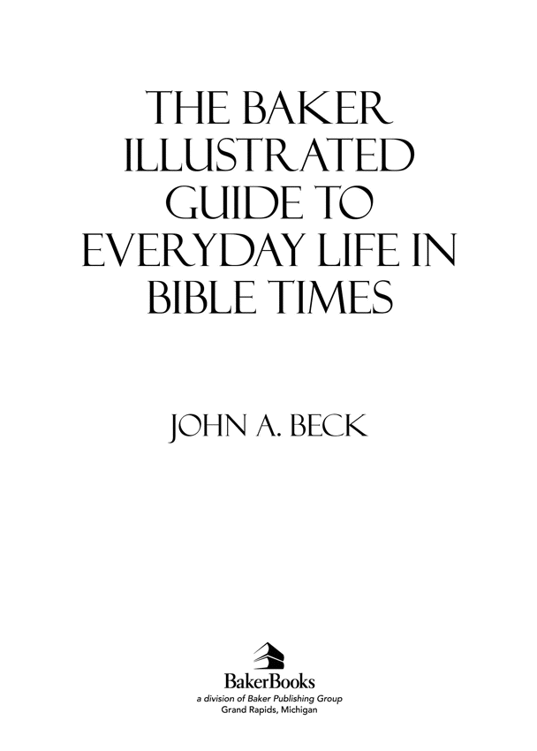
2013 by John A. Beck
Published by Baker Books
a division of Baker Publishing Group
P.O. Box 6287, Grand Rapids, MI 49516-6287
www.bakerbooks.com
Ebook edition created 2013
All rights reserved. No part of this publication may be reproduced, stored in a retrieval system, or transmitted in any form or by any meansfor example, electronic, photocopy, recordingwithout the prior written permission of the publisher. The only exception is brief quotations in printed reviews.
Library of Congress Cataloging-in-Publication Data is on file at the Library of Congress, Washington, DC.
ISBN 978-1-4412-4488-8
In order to optimize the reading experience of The Baker Illustrated Guide to Everyday Life in Bible Times in ebook format, the author carefully selected 200 full-color images from the print edition to include in the ebook. The print edition includes more than 300 full-color photos.
Unless otherwise indicated, Scripture quotations are from the Holy Bible, New International Version. NIV. Copyright 1973, 1978, 1984, 2011 by Biblica, Inc. Used by permission of Zondervan. All rights reserved worldwide. www.zondervan.com
Scripture marked NASB is taken from the New American Standard Bible, copyright 1960, 1962, 1963, 1968, 1971, 1972, 1973, 1975, 1977, 1995 by The Lockman Foundation. Used by permission. www.lockman.org
Scripture marked NLT is taken from the Holy Bible , New Living Translation, copyright 1996, 2004, 2007 by Tyndale House Foundation. Used by permission of Tyndale House Publishers, Inc., Carol Stream, Illinois 60188. All rights reserved.
Scripture marked TNIV is taken from the Holy Bible, Todays New International Version. TNIV. Copyright 2001, 2005 by Biblica, Inc. Used by permission of Zondervan. All rights reserved worldwide. www.zondervan.com
Interior design by Brian Brunsting
For my soul mate, Marmy. She is worth far more than rubies. Her husband has full confidence in her and lacks nothing of value.... She sees that her trading is profitable, and her lamp does not go out at night.... She is clothed with strength and dignity.... Many women do noble things, but you surpass them all (Prov. 31:1011, 18, 25, 29).
And for Judah, our first grandchild, who joined the kingdom of God during the writing of this book, in partial fulfillment of Gods clear encouragement: These commandments that I give you today are to be on your hearts. Impress them on your children. Talk about them when you sit at home and when you walk along the road, when you lie down and when you get up (Deut. 6:67).
Contents
Cover
Title Page
Copyright Page
Dedication
Preface
Anoint
Armor-Bearer
Arrow (to shoot)
Authority (to hold or to exercise)
Bake Bread
Belt (to wear or to tuck)
Birth
Blind
Borrow/Lend
Bow Down (to kneel)
Bread (to eat)
Bridegroom
Bury the Dead
Cast Metal
Circumcise
Clap Hands
Clean/Unclean
Concubine
Cross the Jordan River
Crown (to wear)
Crucify
Dance
Destroy (Hebrew, hrm )
Divination (to practice)
Divorce
Dream (to have or to interpret)
Drunk (to become)
Dry (to be or to experience drought)
Eat
Engrave
Exile
Famine
Fast
Firstborn Son
Fish
Flog (whip, scourge)
Fly
Foot (to place on)
Fortify
Foundation (to lay)
Glean
Greet
Grind
Hand (to raise or stretch out)
Harvest (reap)
Hunt
Inherit
Kiss
Lamp (to light a)
Lay On Hands
Lots (to cast)
Measure
Melt
Milk (to drink)
Mountain (to move)
Mourn (to grieve)
Naked
Name (to give a)
Orphan (fatherless)
Pharisee
Plant/Sow
Pledged to Be Married (betrothed/engaged)
Plow
Plunder
Potter (pottery manufacture)
Prostitute
Quarry (to hew)
Ride
Run
Sabbath (to observe)
Sacred Stone (to set up or to destroy)
Sadducee (chief priest)
Sandals (to remove)
Scribe (secretary)
Shave
Shear
Shipwreck
Siege (besiege)
Sift (with a sieve)
Sit
Slave (to become or to be freed)
Sleep
Sling (a projectile)
Smelt (to refine metal)
Stiff-Necked
Stoning (as a form of execution)
Stranger (alien)
Tax Collector
Tear a Garment
Tent Peg/Stake (to drive)
Thresh
Trap/Snare
Vineyard (to establish)
Wash Clothes
Water (to acquire or to draw)
Weave
Weigh
Widow
Winnow
Yoke (to wear a)
Notes
Image Credits
Scripture Index
About the Author
Back Ad
Back Cover
Preface
O ur days pulse with ordinary activities and experiences. We wash our clothes, download music, and stop at the store to purchase a loaf of bread. We execute our roles in life as firefighters, software technicians, and grandparents. Similar activities filled the lives of those living in Bible times. What was ordinary for them, however, may appear quite extraordinary to us. The notions of winnowing grain, removing ones footwear during a land purchase, or milking a goat were well known to those living in Bible times. But the very nature of these activities and the connotations linked to them may puzzle contemporary Bible readers. What did an armor-bearer do? What did it mean to be a Pharisee? What social disadvantages were faced by the childless widow? What was the difference between a wife and a concubine? How did people hunt? How were names given? How was someone executed by stoning? How were ancient cities fortified? What was a lot and how was it cast?
I trust that Abraham, Ruth, and Paul were not harmed by their ignorance of twenty-first-century culture, but modern Bible readers can be harmed by their ignorance of the biblical world. That is because the Holy Spirit often guided the inspired authors of the Bible to include mention of practices and customs from their time in this important book. God intends for these cultural images from the past to change us. But the rhetorical impact of the imagery is often muted because of the distance in time and experience between the modern readers of the Bible and its ancient human authors.
The goal of this visual guide is to restore clarity and vitality to those portions of Gods Word that speak of the activities and social stations of the past. Each article discusses the literal realities that attended the activity or role under consideration. This includes the necessary treatment of the cultural connotations linked to it. The article will then illustrate the ways in which the biblical authors used either literal or figurative reference to the idea under discussion as they sought to change and shape us as their readers. You will find these cultural practices from the past to be fascinating on their own. But more importantly, your experiences with these images from daily life will give you fresh interpretive insights that will deepen your understanding of the most important book you will ever read.
Anoint
O live oil was a signature product of the Promised Land (Deut. 8:8), and it was used in many different dimensions of daily living. Among them was application to the skin after being mixed with aromatics. This was designed to mitigate the harmful effects of a sunny, dry climate and also served to mask ones personal body odor in a place where bathing occurred infrequently due to the lack of fresh water (Ruth 3:3; 2 Sam. 12:20; Dan. 10:3). The biblical authors also knew of a unique application of oil to the body that was given a special designation: anointing . This was not done with ordinary oil but with oil specifically produced for this ritual. The recipe is given in Exodus 30:2225, and it is also called the oil of joy (Ps. 45:7) or holy oil (Ps. 89:20 NASB). A stern set of guidelines accompanied with penalties to match ensured that this special oil was used only for ritual anointing (Exod. 30:3738). At Gods direction, the special oil was poured on the head of a person to mark him or her for special service whether as a member of Israels clergy, as a political leader, or as a prophet.


